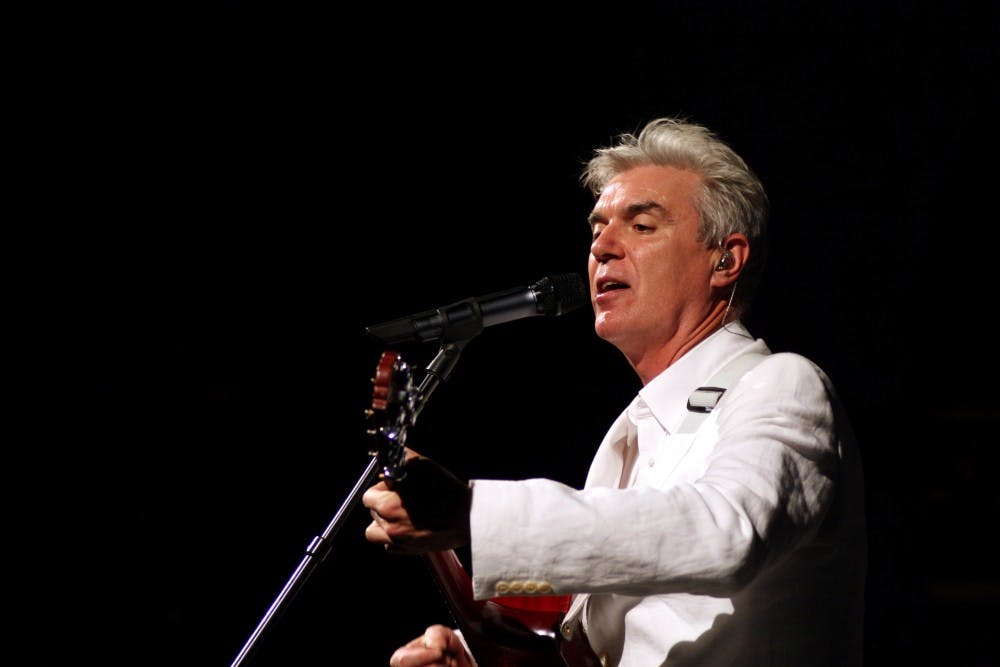After taking their bows following a lively performance of the Talking Heads’ “The Great Curve,” David Byrne and his backing musicians headed back on stage for one last number: Janelle Monáe’s 2015 protest song “Hell You Talmbout.”
The song lists the names of African-American men and women killed in acts of racial violence — many by police officers. The names included Trayvon Martin, Michael Brown and Eric Garner. The cover was a powerfully stark, if not unexpected, ending to a night that covered Byrne’s over-40 year career.
Byrne, the new wave veteran who fronted the Talking Heads as well as working with Brian Eno, St. Vincent, De La Soul, Fatboy Slim and others throughout his solo career, played at the Center for the Arts on Tuesday night to a sold-out crowd. The 21-song show was the third stop of a six-month tour to promote his first proper solo album in 14 years, “American Utopia.” The band featured 11 touring musicians in addition to Byrne himself. Half of them were percussionists, giving each song a fully fleshed-out rhythm section that the remaining musicians could play and groove with.
Though the show concluded with a strong political anthem, it began calmly and casually, with Byrne walking out barefoot with the house lights still on. He looked at the crowd, said, “Hi,” and received a standing ovation.
“This is not how a show starts. I’m not going to do a comedy routine or something,” Byrne said to the crowd. He paused, smiled and joked that maybe he should try starting with some stand-up comedy.
Byrne said because the show was so early in the tour, there would be “some stuff that will probably get cut,” and the crowd at the CFA was “seeing it before anyone else.”
Byrne employed the type of choreography and set design he’s used throughout his career, but with a fresh approach that kept it from being a simple carbon copy of the famous “Stop Making Sense” concert film from 1984. The film captured what is considered by many — including Byrne himself — to be the most ambitious show of his career and introduced what would become iconic images of Talking Heads: big suits, herky-jerky choreography and an ever-building stage set designed to show the audience how the live sound was constructed.
The music started with three rows of beads slowly rose out of the floor, lit up to create a wall of light around the stage. Byrne sat alone at a table, singing “Here,” a song about the mind’s connection to music, to a model of a brain. One by one, the band walked in through the wall of light, barefoot and wearing grey suits, matching Byrne’s outfit.
Instead of building a set for the musicians to play on, Byrne created a flowing, moving stage of sound. Every member carried their instrument — the traditional drum-set deconstructed and spread among six players — and mimicked Byrne’s sporadic movements.
Each song had its own setup of props, lights and movements. In “I Should Watch TV,” a song from his album with St. Vincent, a square white light shone out from the bead wall. Byrne stared in wonder at the implied television set as the band stood back, watching him interact with the light. At the end of the song, Byrne stepped through the bead wall and into the television.
Other pieces had setups that weren’t so directly symbolic of the lyrics, instead simply adding a visual element. On the Talking Heads’ song “Blind,” a strong light sitting on the front of the stage faced the band, creating a shadow silhouette on the back wall. Whoever stood closest to the light would cast the biggest shadow. The musicians continuously shifted position. Byrne stood in front while he was singing, a drummer stood in front during a solo and the dancers stood in front during a breakdown.
While Byrne didn’t play some of Talking Heads’ biggest hits like “Psycho Killer” or “Take Me to the River,” he did perform crowd pleasers like “Once in a Lifetime,” confusedly stumbling around stage in homage to the famous music video, and “Burning Down the House.” Both songs were met with standing ovations and aisles full of dancing fans.
Byrne’s new album, “American Utopia,” comes out this Friday. His next show is on the same day at Palace Theater in Waterbury, Connecticut.
Dan McKeon is the copy chief and can be reached at dan.mckeon@ubspectrum.com and @Dan_McKeon_.





